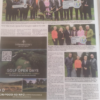An under-reported aspect of Cootehill’s history will have its turn in the spotlight as a new book will celebrate the history of All Saints Church.
Eager to celebrate the 200th anniversary of the impressive Church of Ireland building that seals the top of Market Street, the church’s congregation agreed with Rector David Moses that a book charting its history would be fitting tribute.
Jonathan Smyth, author of the popular Times Past column for this paper, was the obvious choice to pen it. It demanded much commitment.
“A lot of 5am starts, hundreds of hours – while also fitting in the Celt column and the family. It’s a relief, I could hit the bed for six months! – I’m delighted it’s done, but I hope that it tells a good story and adds another dimension to the history of Cootehill.”
Jonathan appears to wear stress lightly. In typical gentle humour and no little hyperbole he likened the research involved to climbing the Andes. That climb was made more treacherous when he discovered that the church’s minute books relating to the years 1818 to 1912. The AWOL records coincided with the year before the church’s construction – 1819. Regardless, an experienced local historian, Jonathan conquered the ascent through other means, and clearly relishes the view from the summit.
“When it fell to me, I wanted to tell the story of the parish, but also appeal to the broader community. I was delighted to find some very interesting things.”
The book, published by Breifne Historical Society, takes readers back through “the deep mists of time”, as Jonathan puts it, when a church on Drumgoon Hill was the focal point of the unified Christian faith in that area. After the Reformation it became a Church of Ireland domain, but eventually fell into ruin. The first base of the Church of Ireland in Cootehill Town was likely to have been a small oblong church built on the slopes of Magheranure, off Church Street, in 1639. It was replaced by a bigger church, which was consecrated with a ceremony in 1715 and officially called St James’ Church.
Just over a century later All Saints would have its day. A loan was obtained and a vacant site selected, which incidentally had a previous religious past.
“The site for the church was the original site on which the first Quakers meeting house stood,” explains Jonathan, noting they had moved on to Drumnaveil Fort.
There remains some doubt over the architect for the landmark building, however Jonathan came across a report mentioning a John Bowden.
“The bishop of the time had to give a report to Westminster – basically there had been difficulties with the structures – there was an issue with the roof and walls. The blame went on John Bowden, but at the time of the report he was dead already, so he couldn’t speak up for himself.”
While the physical building of the church merits attention in the book, of at least equal interest are the people, rectors and congregation members who make up the church.
Readers will encounter numerous interesting people, including Rev Archibald Douglas who in the 1830s and ‘40s was, contrary to expectations, became very good friends with the Catholic bishop of Kilmore.
“We always hear the stories where people were out with pitchforks and riots, but actually – it’s very interesting because they worked on several projects together, and all for the betterment of the town.”
An example of their teamwork came in the 1830s, a time when linen was second only to farming in significance for the town’s economy.
“Weavers were suffering,” says Jonathan. “The bigger dealers were buying up all the material and the smaller weaver couldn’t afford it so they were getting only piecemeal work.”
The two clergy men set up a loan fund society to help the beleaguered weavers.
One of Rev Douglas’s successors, Rev John Richard Darley, was similarly ecumenical in his outlook during his 16 years in Cootehill, commencing in 1850. He proved a popular and pivotal figure in the history of All Saints’.
“He founded the Darley School in Cootehill – he put up his own money to build the original school, and now you have Darley Health Centre there today,” explained Jonathan, who approvingly adds that “he looked out for everybody”. Before coming to Cootehill he had been a principal in the Royal School, Dungannon
“He was happy to accept people of a Catholic religion into the school, but he felt at a loss that he wouldn’t be able to teach them their religion – that was a nice thing.”
Rev Darley’s time at All Saints saw congregations swell, with a total of 60 children on the list for confirmation in one year, and a tripling of Sunday School attendance. In 1862 – just over 40 years after the church was built it had to be extended with an extra wing. Rev Darley later become Bishop of Kilmore. His memory survives to this day with stained glass windows dedicated to him in both Cootehill and Kilmore Cathedral.
Other fascinating characters also pop up along the way such as Eric Dorman-Smith, AKA Brigadier O’Gowan, who was a national figure at the time having masterminded a crucial battle victory over the Nazis, which proved a turning point in World War II. After clashing with the authorities he became disillusioned and later supported the IRA during their ill-fated border campaign. A member of the congregation, O’Gowan donated the site for a new rectory, in additional to giving two parts of Bellamont Estate to the people of Cootehill as an amenity in 1969.
There’s also Dr Henry Leadbeater who in the early 1800s “was offered a knighthood but he turned it down”, and the colourful Lady Edith Windham from Dartrey Estate who was an animal rights activist back in the 1930s. There’s also the tragic story of Walter Woods, who competed at a high level in showjumping events and badminton tournaments. Aged just 31 he passed away on the very day his father died; presumably from the grief of losing his father.
“Hugh O’Brien tells the story of the two hearses drawn by black horses took coffins out through the town – it was a very sad day for the town,” says Jonathan.
As he leafs through the pages, he points out surnames that survive down the centuries, and can be found occupying the pews of All Saints’ at Sunday Service. Amongst those family names are Jonathan’s own. He delves into the book to locate a fabulous black and white photo of Cootehill Station in its pomp with one of the Great Northern line’s stunning engines exhaling steam, a handful of railway men in flat caps posing, and Jonathan’s great grandfather Hugh Smyth wearing a bowler. A native of the town, Hugh lived with his wife Annie upstairs in the stationhouse.
“They lived at the Railway house at the time of the Troubles – the early 20s. The authorities of the time were bringing prisoners through. His wife didn’t like to see anyone mistreated, and she often insisted that they were brought upstairs and made them a fry-up,” he recalls with obvious admiration for Annie’s compassion.
Examples where cross community relations were especially harmonious – such as a joint cycle from Dublin to Cootehill in the 1980s to show unity during the grim days the recent Troubles – were emphasised by Jonathan. Pushed by the Celt, he accepts that there were more unsavoury incidents between the two faiths.
“I didn’t want to dwell on that,” says Jonathan unapologetically, stressing that such incidents have been well documented elsewhere, and he has footnoted appropriately to permit further exploration.
Of his hopes for the book, Jonathan says to “do honour and justice to the story” of All Saints Church and in turn contribute to the local history of the area.
“Local history was always something I was very interested in. My mother and father were very good at collecting any local history books that used to come out. I used to love reading through ‘Images of Drumgoon’ by Aogán Ó Fearghaíl and Hugh O’Brien’s book on St Michael’s Church – that sort of thing. I used to pore over them, I loved reading about my own hometown. That’s what got me into history.
“What I’m hoping is that people will be happy enough to put this alongside those books, because those local history books are treasured books for me.”
Broadening the history of Cootehill





